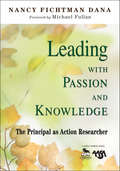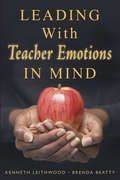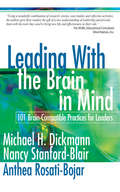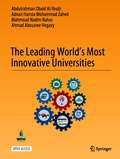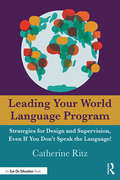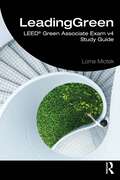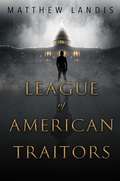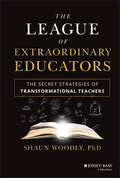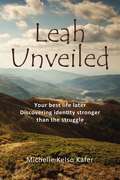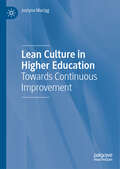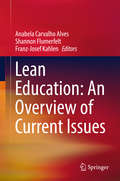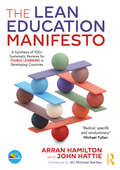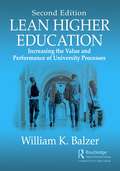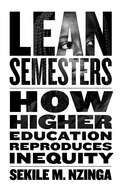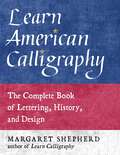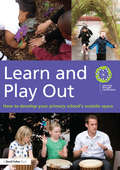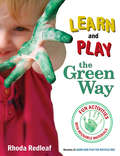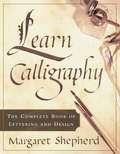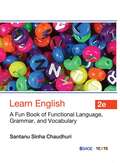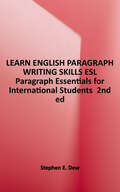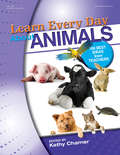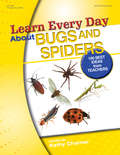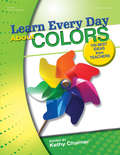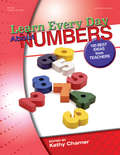- Table View
- List View
Leading With Passion and Knowledge: The Principal as Action Researcher
by Nancy Fichtman DanaBecome the “head learner” in your school by engaging in action research! Action research can serve as a critical element in the professional development of principals, administrators, and school leaders. Award-winning author Nancy Fichtman Dana guides leaders in identifying and exploring areas of interest for principal research, including staff development, curriculum development, individual teachers, community/culture building, leadership skills, building management, and school performance.
Leading With Teacher Emotions in Mind
by Kenneth A. Leithwood Brenda BeattyThis research-based study helps administrators create a school environment that responds to teacher emotions and results in higher teacher retention, instructional effectiveness, and student achievement.
Leading With the Brain in Mind: 101 Brain-Compatible Practices for Leaders
by Michael H. Dickmann Professor Nancy Stanford-Blair Dr Anthea L. Rosati-BojarThe authors present a broad repertoire of highly practical "how to" strategies and practices for building capacity and achieving results in a learning organization.
The Leading World’s Most Innovative Universities
by Abdulrahman Obaid AI-Youbi Adnan Hamza Zahed Mahmoud Nadim Nahas Ahmad Abousree HegazyThis open access book is unique in its contents. No other title in the book market has tackled this important subject. It introduces innovation as a way of practice for world-class universities. It, then, discusses the criteria for being innovative in the academic world. The book selects some of the top innovative world-class universities to study the factors that qualified them to be innovative, so that any other university can follow their steps to become innovative. The final chapter of the book presents some recommendations in this regard.
Leading Your World Language Program: Strategies for Design and Supervision, Even If You Don’t Speak the Language!
by Catherine RitzAn essential resource for district, school, and program leaders who supervise, evaluate, or otherwise support World Language programs, this book provides clear, practical guidance on leading an exemplary K–12 World Language program. No matter whether you speak the language, the effective approaches in this book will equip you with the tools you need to implement and evaluate World Language curricula in your school. Catherine Ritz provides a clear and research-based framework for World Language instruction aligned to rigorous national and state standards, and addresses essential concepts and topics, including program and curriculum design, assessment and evaluation, and strategic planning. Whether you are a World Language department chair with years of experience, a school administrator with no background in language education, or a World Language teacher, you will find much to use in this book. It is chock-full of ready-to-use resources and tools, including: Templates for program and unit planning, observation protocols, and sample assessments World LAnguage program models for different age ranges, and a sample curriculum unit Additional resource lists and further reading recommendations.
LeadingGreen: LEED® Green Associate Exam v4 Study Guide
by Lorne MlotekLeadingGreen: LEED® Green Associate Exam v4 Study Guide brings together a concise introduction to the core concepts behind the LEED green building rating system with efficient, effective test preparation for the LEED® Green Associate Exam. The guide provides an essential foundation in principles of sustainable design and construction for students and professionals in the areas of architecture, engineering, construction, real estate development, urban planning, and environmental policy. If you are interested in passing the LEED® Green Associate Exam, this is the right place to start. The background, objectives, and evolution of green building standards – as well as what actually goes into a LEED building – are covered in a clear and straightforward manner. Tailored to precise exam expectations, the guide breaks down the key LEED categories one credit at a time. Drawing upon the author’s extensive experience as a LEED educator for universities and professional firms around the world, the guide includes proven tips and tricks that have helped over 10,000 people pass the Green Associate Exam. An ideal resource for self-study, LeadingGreen: LEED® Green Associate Exam v4 Study Guide will benefit readers from all built environment professions in which LEED credentials are an asset.
League of American Traitors
by Matthew LandisThose who don’t know history are destined to repeat it . . . When seventeen year-old Jasper is approached at the funeral of his deadbeat father by a man claiming to be an associate of his deceased parents, he’s thrust into a world of secrets tied to America’s history—and he’s right at the heart of it. First, Jasper finds out he is the sole surviving descendant of Benedict Arnold, the most notorious traitor in American history. Then he learns that his father’s death was no accident. Jasper is at the center of a war that has been going on for centuries, in which the descendants of the heroes and traitors of the American Revolution still duel to the death for the sake of their honor.His only hope to escape his dangerous fate on his eighteenth birthday? Take up the research his father was pursuing at the time of his death, to clear Arnold’s name. Whisked off to a boarding school populated by other descendants of notorious American traitors, it’s a race to discover the truth. But if Jasper doesn’t find a way to uncover the evidence his father was hunting for, he may end up paying for the sins of his forefathers with his own life.Like a mash-up of National Treasure and Hamilton, Matthew Landis’s debut spins the what-ifs of American history into a heart-pounding thriller steeped in conspiracy, clue hunting, and danger.
The League of Extraordinary Educators: The Secret Strategies of Transformational Teachers
by Shaun WoodlyDeliver on the promise of equity and transformational instruction in your classroomIn The League of Extraordinary Educators, veteran educator Dr. Shaun Woodly delivers a rousing narrative designed to take readers on a journey of empowerment, motivation, rich learning experiences, classroom synergy and even secrecy! You’ll learn how to transform teaching and learning through empowering connections at all levels in the classroom, saying goodbye to outdated, ineffective teaching practices and saying hello to instructional methods that authentically captivate students from diverse backgrounds.In the book, you’ll also find: Transformative practices that emerge from a combination of inspiration, mindset shifts, as well as practical techniques and strategies A focus on the importance of human connection, culturally significant learning experiences and community in the classroom A revolutionary story the reveals the secret strategies of transformational educations in urban and culturally diverse schools An indispensable resource for K-12 teachers, instructional staff, as well as leaders and administrators facing tough issues around creating meaningful learning experiences for students from underserved and underrepresented backgrounds, The League of Extraordinary Educators will set the stage for learning environments that authentically engage to create equitable academic outcomes for all students. All meaning all!
Leah Unveiled: Your Best Life Later, Discovering Identity Stronger than the Struggle
by Michelle KaferIn the book of Genesis, we see creation, God&’s pursuit in covenant, displays of righteousness and faith, but also humanity&’s rebellion, judgment, racism, social inequality, and depravity run amuck. We see the difference in walking by faith with God and walking by worldly standards. We see holy justice and raw human injustice. In Genesis chapters 29 and 30, there is no shortage of these elements, where God chose to preserve a diary, of sorts, of a matriarch of the faith. Though history has reduced her story to only descriptive paragraphs, this twelve-week Bible study will unveil why God chose to carry her testimony for our benefit in living out the Christian life. God took her humble position and grafted her into the scarlet thread of the Gospel story. You know her as the wife to a patriarch, who was in love with her sister, and a mother to eight of the original twelve tribes of Israel. Her name is Leah. After this expository styled study, you will be astonished and captivated by her testimony of how faith wrestles to thrive in the land of the living while yielding to the hope of heaven. She is a channel by which world history has been shaped and our hope secured in Christ. You will be encouraged and convicted as you wrestle with the God who revealed Himself to her and who stands to do the same for you.
Lean Culture in Higher Education: Towards Continuous Improvement
by Justyna MaciągThis book deepens the understanding of cultural conditions for implementing organizational and process changes in higher education institutions. Developing the humanistic and critical trend in Lean management research, it aims to define the notion and maturity of a Lean culture in higher education institutions as well as to determine its key dimensions and descriptions in the light of adopted ontological and epistemological assumptions. This book defines the notion of Lean Culture, proposes a model to assess its maturity, determines conditions for its implementation, and presents the tools of the Lean management model in a university. It supplements the issues related to the implementation of the Lean concept by adopting a humanistic approach.
Lean Education: An Overview of Current Issues
by Anabela Carvalho Alves Shannon Flumerfelt Franz-Josef KahlenThis edited volume presents a structured approach to a new lean education curriculum, implemented for the education of engineers, managers, administrators as well as human resources developers. The authorship comprises professors and lecturers, trainers and practitioners who educate future professionals in Lean Thinking principles and tools. This edited book provides a platform for authors to share their efforts in building a Body of Knowledge (BoK) for Lean Education. The topical spectrum is state-of-the-art in this field, but the book also includes a glimpse into future developments. This is a highly informative and carefully presented book, providing valuable insight for scholars with an interest in Lean Education.
The Lean Education Manifesto: A Synthesis of 900+ Systematic Reviews for Visible Learning in Developing Countries
by Arran Hamilton John HattieThe global expansion of education is one of the greatest successes of the modern era. More children have access to schooling and leave with higher levels of learning than at any time in history. However, 250 million+ children in developing countries are still not in school, and 600 million+ attend but get little out of it – a situation further exacerbated by the dislocations from COVID-19. In a context where education funding is stagnating and even declining, Arran Hamilton and John Hattie suggest that we need to start thinking Lean and explicitly look for ways of unlocking more from less. Drawing on data from 900+ systematic reviews of 53,000+ research studies – from the perspective of efficiency of impact – they controversially suggest that for low- and middle-income countries: Maybe pre-service initial teacher training programs could be significantly shortened and perhaps even stopped Maybe teachers need not have degree-level qualifications in the subjects they teach, and they might not really need degrees at all! Maybe the hours per week and years of schooling that each child receives could be significantly reduced, or at least not increased Maybe learners can be taught more effectively and less resource intensively in mixed-age classrooms, with peers tutoring one another Maybe different approaches to curriculum, instruction, and the length of the school day might be more cost-effective ways of driving up student achievement than hiring extra teachers, reducing class sizes, or building more classrooms Maybe school-based management, public–private partnerships, and performance-related pay are blind and expensive alleys that have limited influence or impact on what teachers actually do in classrooms. This groundbreaking and thought-provoking work also identifies a range of initiatives that are worth starting. It introduces the Leaning to G.O.L.D. methodology to support school and system leaders in selecting, implementing, and scaling those high-probability initiatives; and to rigorously de-implement those to be stopped. It is essential reading for anyone with an interest in education.
Lean Higher Education: Increasing the Value and Performance of University Processes, Second Edition
by William K. BalzerIn an environment of diminishing resources, growing enrollment, and increasing expectations of accountability, Lean Higher Education: Increasing the Value and Performance of University Processes, Second Edition provides the understanding and the tools required to return education to the consumers it was designed to serve – the students. It supplies a unifying framework for implementing and sustaining a Lean Higher Education (LHE) transformation at any institution, regardless of size or mission. Using straightforward language, relevant examples, and step-by-step guidelines for introducing Lean interventions, this authoritative resource explains how to involve stakeholders in the delivery of quality every step of the way. The author details a flexible series of steps to help ensure stakeholders understand all critical work processes. He presents a wealth of empirical evidence that highlights successful applications of Lean concepts at major universities and provides proven methods for uncovering and eliminating activities that overburden staff yet contribute little or no added value to stakeholders. Complete with standardized methods for correctly diagnosing workplace problems and implementing appropriate solutions, this valuable reference arms you with the understanding and the tools to effectively balance the needs of all stakeholders. By implementing the Lean practices covered in these pages, your school will be better positioned to provide higher quality education, at reduced costs, with efficient processes that instill pride, maximize value, and respect the long-term interests of your students, faculty, and staff. This second edition contains a substantial update with expanded material and reflects the significant growth of LHE practices in colleges and universities worldwide. Because of advances in best practices, as well as some modest research-based evidence, this second edition includes many enhancements that provide particular value to LHE practitioners and higher education (HE) leaders. Since the initial publication of Lean Higher Education in 2010, the challenges of cost and affordability, competition for students and faculty, and calls for efficiency and accountability have only continued to grow, requiring colleges and universities to pursue more radical and transformative change to ensure their success. This new edition provides a model for change based on more than 50 years of application in business and industry and almost 20 years in HE. It provides the information and evidence demanded by HE leadership to understand and embrace LHE as well as best practices processes and tools for implementing LHE in targeted areas or institution-wide. This book provides a conceptual framework for redesigning any university process, such as admitting students, paying a bill, hiring faculty, or processing a donor gift, in a way that delights the beneficiary of that process, respects the employees who support the process, and reduce the cost of the process.
Lean Semesters: How Higher Education Reproduces Inequity (Critical University Studies)
by Sekile M. NzingaMore Black women are graduating with advanced degrees than ever before. Despite the fact that their educational and professional opportunities should be expanding, highly educated Black women face strained and worsening economic, material, and labor conditions in graduate school and along their academic career trajectory. Black women are less likely to be funded as graduate students, are disproportionately hired as contingent faculty, are trained and hired within undervalued disciplines, and incur the highest levels of educational debt. In Lean Semesters, Sekile M. Nzinga argues that the corporatized university—long celebrated as a purveyor of progress and opportunity—actually systematically indebts and disposes of Black women's bodies, their intellectual contributions, and their potential en masse. Insisting that "shifts" in higher education must recognize such unjust dynamics as intrinsic, not tangential, to the operation of the neoliberal university, Nzinga draws on candid interviews with thirty-one Black women at various stages of their academic careers. Their richly varied experiences reveal why underrepresented women of color are so vulnerable to the compounded forms of exploitation and inequity within the late capitalist terrain of this once-revered social institution.Amplifying the voices of promising and prophetic Black academic women by mapping the impact of the current of higher education on their lives, the book's collective testimonies demand that we place value on these scholars' intellectual labor, untapped potential, and humanity. It also illuminates the ways past liberal feminist "victories" within academia have yet to become accessible to all women. Informed by the work of scholars and labor activists who have interrogated the various forms of inequity produced and reproduced by institutions of higher education under neoliberalism, Lean Semesters serves as a timely and accessible call to action.
Learn American Calligraphy: The Complete Book of Lettering, History, and Design
by Margaret ShepherdTake a visual trip around the United States, with stop-offs in many locations and insights on every page, and illuminate the past and future of American calligraphy. For centuries, American calligraphers have accepted the legacy of the classic Roman, Gothic, and Italic calligraphy they inherited from Europe without realizing that there are more alphabet treasures to be found in a larger pool of uniquely American alphabet designs. Wild West, New Deal, Prairie—all were made in America, and they express ideas that reveal national character. These styles come from here and nowhere else. Much like American music, language, fashion, and philosophy, calligraphy has matured, moved on from its origins, and become, in the words of the man who created Spencerian handwriting, &“even more American.&” Learn American Calligraphy is the latest book from Margaret Shepherd, author of one of the all-time bestselling books on calligraphy, Learn Calligraphy. This new book focuses on American calligraphy, which has its own identity, distinct from the alphabets inherited from Europe. As a lifelong calligrapher, Shepherd surveys the landscape of unique styles and describes how two dozen alphabets originated and what shaped them. Simple diagrams and exercises help you try out the styles for yourself. Some letters represent a region or a major era of art; some bear witness to social upheaval or culture change; many are accessible to beginners; and a few contradict the established view of American history.
Learn and Play Out: How to develop your primary school's outside space
by Learning through LandscapesDo your children know how to grow potatoes, where to see a dragon-fly or how to fire a rocket? Are you one of the 82% of teachers who thinks their school isn’t making as much use of their grounds as they should? Do you know how to make the most of your outdoor teaching and learning spaces? Learn and Play Out is an inspirational, accessible and pragmatic set of resources for making changes to Primary school playgrounds in order to provide high quality learning and play experiences. Drawing on Learning through Landscapes’ experience in working with thousands of primary schools, it provides practical support to improve the use, design and management of your outdoor area. More schools are seeing the benefits of their pupils spending longer periods of their school day outside, with research showing that this improves attainment, behaviour, motivation and self-esteem. For many schools however, the environment of their grounds does not meet the needs of their pupils. This toolkit helps them assess what they already have, work through what their needs are, and inspires them to take the next steps forward to make physical and practical improvements to their grounds. Featuring a CD ROM with a comprehensive and fully adaptable audit tool, plus activities and case study resources to support your work, the handy toolkit provides: An overview of what your school grounds can do for you; A step-by-step process to work through; Advice on how to involve the whole school community in planning changes; Guidance on managing your school grounds project; Practical activity ideas to involve children and adults. This illustrated resource which contains over 140 full colour photos will make it as easy as possible for teachers, parents and school governors to plan and manage a playground improvement project, involving children at the core of the work and linking the process and improved school grounds to curriculum learning objectives.
Learn and Play the Green Way
by Rhoda RedleafDon't throw it away-use it for play!Turn items headed for the trash into fun, educational, and safe toys and activities for young children. Find one hundred creative and clever ideas repurposing common household objects-including shoeboxes, fabric scraps, plastic lids, and buttons-into entertaining playthings. The toys benefit children's early learning by promoting sensory perception and development in physical; social and emotional; cognitive; and language and communication areas.Organized by age group, Learn and Play the Green Way has sections for working with infants, toddlers, preschoolers, and schoolagers. Each activity includes:A description of the ways children might use the toySuggestions for extending the learningA list of materials needed and step-by-step instructionsA green idea for additional ways to be eco-friendlyLearn and Play the Green Way: Fun Activities with Reusable Materials is a revision of the bestselling, award-winning Learn and Play the Recycle Way: Homemade Toys that Teach.
Learn Calligraphy: The Complete Book of Lettering and Design
by Margaret ShepherdIn an age of myriad computer fonts and instant communication, your handwriting style is increasingly a very personal creation. In this book, Margaret Shepherd, America's premier calligrapher, shows you that calligraphy is not simply a craft you can learn, but an elegant art form that you can make your own.Calligraphy remains perennially popular, often adorning wedding invitations, diplomas, and commercial signs. Whether it is Roman, Gothic, Celtic, Bookhand, or Italic style, calligraphy conveys class and elegance. Margaret Shepherd makes this ancient art form accessible in a completely hand-lettered technical guide that will:* Provide context for calligraphy as an art, exploring the rich tradition of hand-lettering and mapping the evolution of the most popular styles.* Give detailed technical advice on choosing pens, paper, and inks, setting up your workspace, mastering various pen angles, along with step-by-step illustrations to guide you as you practice. * Explain which alphabets are appropriate for different forms of writing. For example, the Roman alphabet works well for short, unpunctuated passages, while the Italic alphabet is more suited to informal everyday communication. * Encourage you to personalize your lettering by using variant strokes and interpreting how you would like the words to look on the page.* Inspire you with carefully chosen illustrations and examples, which bring letters to life.In Margaret Shepherd's own words, "Calligraphy trains not only your eye and hand, but your mind as well." Learn Calligraphy is the authoritative primer for this age-old craft, and will help develop a new appreciation for lettering as you discover your creative personality.
Learn English: A Fun Book of Functional Language, Grammar, and Vocabulary
by Santanu Sinha ChaudhuriA one-book army that will demolish your fear of and troubles with English! If you wish to improve your English but don't know where to begin, try reading this book. Learn English is a complete package that presents the fundamentals of the English language in an enjoyable, reader-friendly style. From basic sentences to complex grammatical forms, from essential English words to modern business vocabulary, and from common errors to elements of style, this book covers them all! As you work through the book, you will find answers to your questions in easy-to-understand, informal language. The book is specifically aimed at South Asians who face similar challenges while learning English. With contexts and stories they can easily relate to, this book offers insights into English in a fun way. It will help you speak and write English with clarity and confidence. This book: • Can an be used either by self-learners or in a classroom • Is based on modern concepts of second language acquisition • Deals with linguistic challenges and cultural aspects from a South Asian perspective
Learn English Paragraph Writing Skills: ESL Paragraph Essentials for International Students (Academic Writing Skills Ser.)
by Stephen E. DewThis book is an academic writing skills guide for International ESL students. The book is the first in a series of academic writing handbooks for international undergraduates, graduates, high school students, and mature-age students of English as a second language. It was designed as a supplementary guide to support IELTS and ESL students' regular English classes. <p><p>What's in it for You? It specifically addresses academic paragraph writing skills and development. In particular, it covers: <p>• What academic writing is <p>• Paragraph format and structure <p>• Paragraph organization <p><p>In addition, it covers more comprehensively the areas of capitalization, punctuation, and sentence structure. The last part, The Academic English Writing Process, details the essential steps to create a mature and confident academic paragraph writer. As the book was designed as a supplementary paragraph writing guide, it does not contain any exercises. It only contains rules, examples, and simple explanations written by an experienced TESOL instructor. This unique academic writing skills guide will teach you good academic writing skills for university entrance. Ideal for the International ESL Student. Get better results with the Academic Writing Skills series.
Learn Every Day About Animals: 100 Best Ideas from Teachers
by Kathy CharnerLearning about ANIMALS has never been so much fun!Even the youngest children love animals; they want to pet puppies, visit lions at the zoo, and imitate animal sounds. Learn Every Day About Animals is an activity book inspired by children's fascination with our furry friends. With this resource, teachers can easily incorporate learning about animals into any curriculum: Games like "Whose Feet Are These?" teach recognition, while "Playdough Porcupine" allows children to explore different art mediums, and "Scratch Like a Monkey" gets children active and moving. Curiosity about our animal friends is natural for children ages 3 to 6, and with Learn Every Day About Animals, the learning has never been more fun! Each activity features: * Learning objectives * Vocabulary * Related children's books * Materials * Preparation (if necessary) * What to do * An assessment component Each of the books in the Learn Every Day series offers teachers 100 classroom-tested activities that make learning fun and engaging for young children!
Learn Every Day About Bugs and Spiders: 100 Best Ideas from Teachers
by Kathy CharnerLearning about BUGS AND SPIDERS has never been so much fun! Bugs and spiders are fascinating to adults and children alike! Now teachers can take children on an expedition into the mysterious world of some of nature's smallest inhabitants, with Learn Every Day About Bugs and Spiders.These easy-to-do activities give children a peek into the lives of our creepy-crawler friends, with activities like "Create Caterpillars" and games like "Ants in Your Pants!" Children will love exploring the world of these mysterious and interesting creatures, and teachers will find the activities in Learn Every Day About Bugs and Spiders to be adaptable, expansive, and most of all, fun!Each activity features: * Learning objectives * Vocabulary * Related children's books * Materials * Preparation (if necessary) * What to do * An assessment component Each of the books in the Learn Every Day series offers teachers 100 classroom-tested activities that make learning fun and engaging for young children!
Learn Every Day About Colors: 100 Best Ideas from Teachers
by Kathy CharnerLearning about COLORS has never been so much fun!The result of a nationwide contest, teachers from around the globe have contributed their favorite classroom activities, all focused on topics that teachers use every day! Organized by curriculum area, the activities in each chapter begin with those that are appropriate for the youngest preschooler and end with activities that six-year-olds will enjoy. Learn Every Day About Colors has 100 activities for children ages 3-6, providing teachers with innovative and fun ways to introduce and reinforce learning about colors. With activities such as My Favorite Color Collage; Rain Painting; The Blue, Blue Sky; and I Can Sing a Rainbow, children will delight in learning all about colors! Each activity features:*Learning objectives *Related vocabulary *Related children's books *Materials needed *Directions for preparation *Instructions for each activity *An assessment component Many activities also feature teacher-to-teacher tips that provide additional ideas for expanding the activity in new ways, or suggestions about finding materials. You will also find related fingerplays, poems, or songs to expand children's learning.This book, along with the other books in the Learn Every Day series, gives teachers 100 activities that make learning fun and engaging for young children!
Learn Every Day About Numbers: 100 Best Ideas from Teachers
by Kathy CharnerLearning about NUMBERS has never been so much fun!Classroom-tested and teacher-approved, these activities help children ages 3-6 learn all about numbers. With 100 engaging and fun activities,Learn Every Day About Numbers offers everything a teacher needs to build a foundation for future math learning. Children will love becoming a Number Detective, a Flashlight Writer, or a Number Hero as they investigate the wonderful world of numbers. Each activity offers learning objectives to meet standards, a materials list, related children's books, and an assessment component to measure children's learning. Learn Every Day About Numbers is sure to become a classroom favorite! Each activity features: *Learning objectives *Related vocabulary *Related children's books *Materials needed *Directions for preparation *Instructions for each activity *An assessment componentMany activities also feature teacher-to-teacher tips that provide additional ideas for expanding the activity in new ways, or suggestions about finding materials. You will also find related fingerplays, poems, or songs to extend children's learning.This book, like each of the other books in the Learn Every Day series, gives teachers 100 classroom-tested activities that make learning fun and engaging for young children!
Learn Every Day About Our Green Earth: 100 Best Ideas from Teachers
by Kathy CharnerLearning about OUR GREEN EARTH has never been so much fun! Taking care of our planet has never been more important, and this book will teach even the youngest children about environmental responsibility. Learn Every Day About Our Green Earth makes it easy for teachers to incorporate discussions about caring for the Earth into any curriculum with activities that promote responsible behaviors and are fun and enjoyable. In this book, activities like "Recycling Adds Up" and "Block Compost" teach children the importance of reusing and recycling, while "Thank a Tree" and "Worms Are Good Guys" teach them to respect and love nature. Global awareness is everyone's responsibility, and the activities in Learn Every Day About Our Green Earth help teachers pass along this important knowledge to the next generation.Each activity features: * Learning objectives * Vocabulary * Related children's books * Materials * Preparation (if necessary) * What to do * An assessment component Each of the books in the Learn Every Day series offers teachers 100 classroom-tested activities that make learning fun and engaging for young children!
